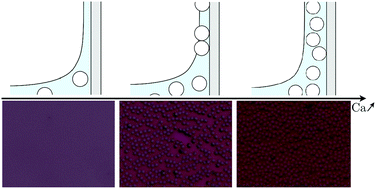Dip-coating of suspensions
Abstract
Withdrawing a plate from a suspension leads to the entrainment of a coating layer of fluid and particles on the solid surface. In this article, we study the Landau–Levich problem in the case of a suspension of non-Brownian particles at moderate volume fraction 10% < ϕ < 41%. We observe different regimes depending on the withdrawal velocity U, the volume fraction of the suspension ϕ, and the diameter of the particles 2a. Our results exhibit three coating regimes. (i) At small enough capillary number Ca, no particles are entrained, and only a liquid film coats the plate. (ii) At large capillary number, we observe that the thickness of the entrained film of suspension is captured by the Landau–Levich law using the effective viscosity of the suspension η(ϕ). (iii) At intermediate capillary numbers, the situation becomes more complicated with a heterogeneous coating on the substrate. We rationalize our experimental findings by providing the domain of existence of these three regimes as a function of the fluid and particles properties.



 Please wait while we load your content...
Please wait while we load your content...